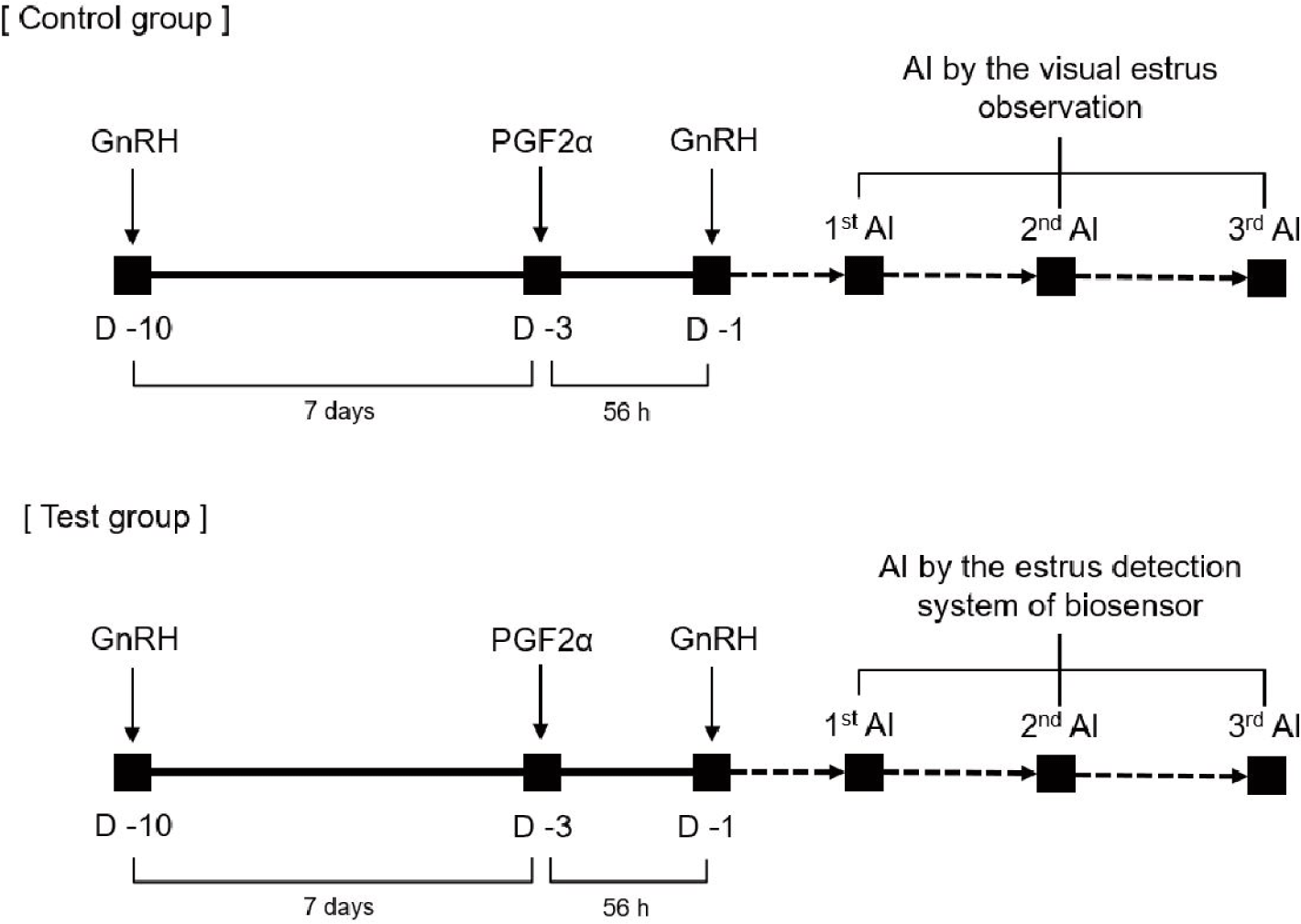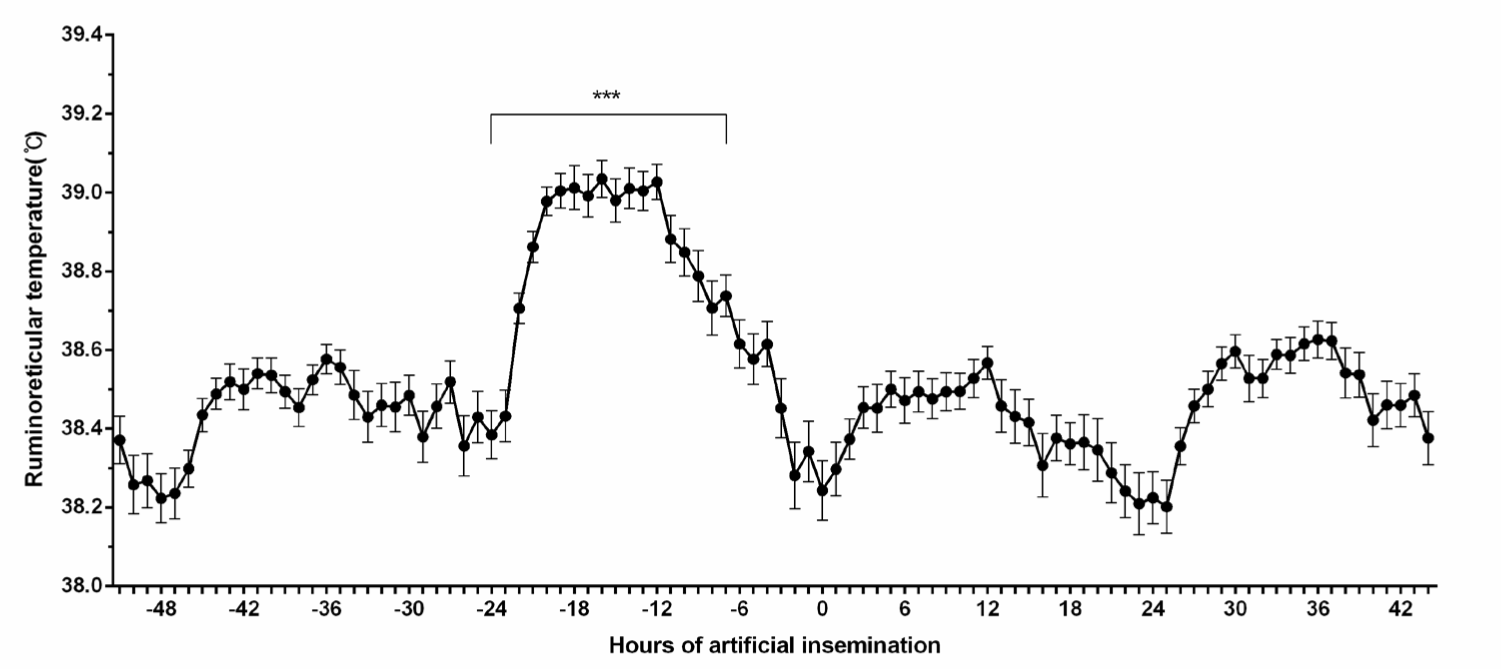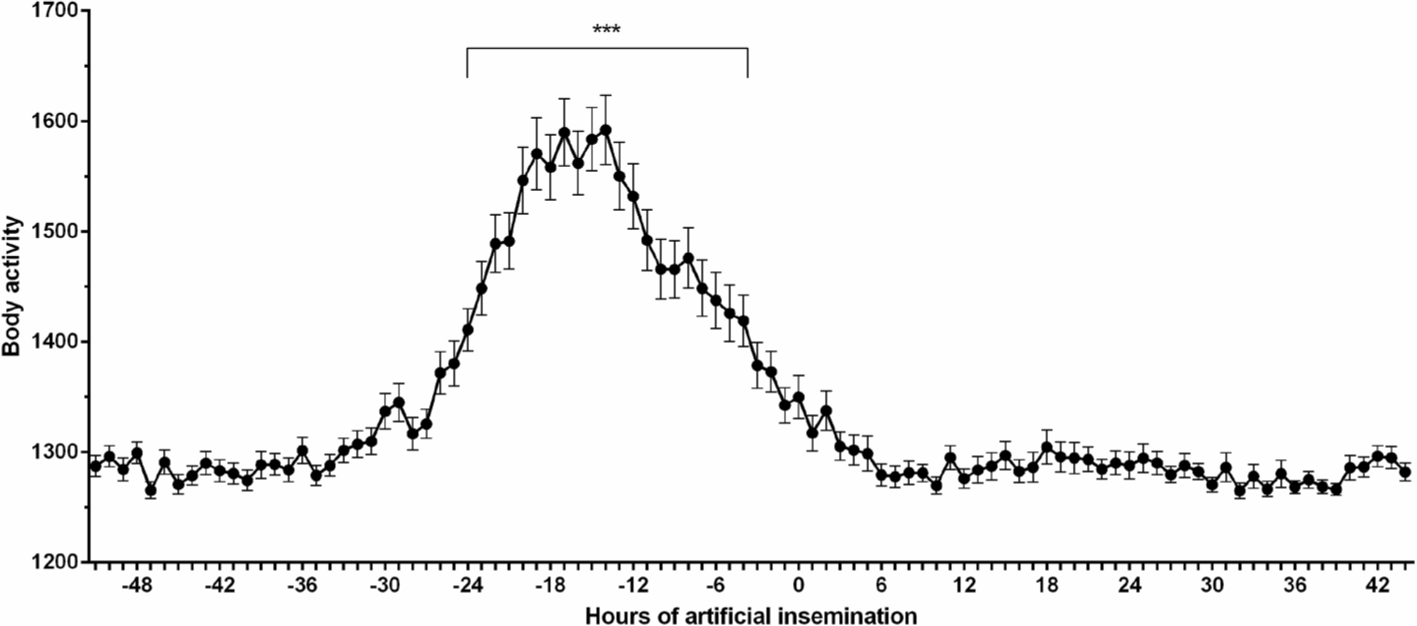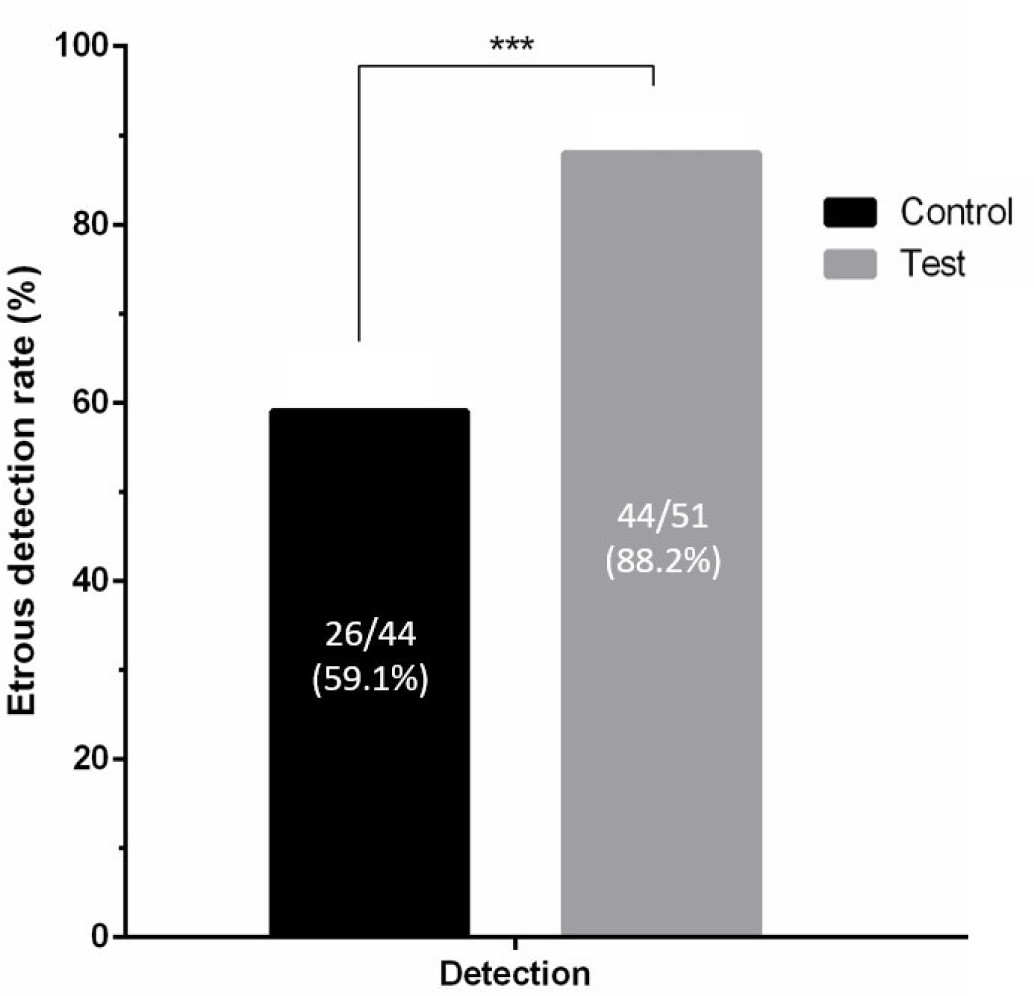INTRODUCTION
Behavioral features, such as standing to be mounted by estrus cows, enhanced mucus, decreased feed intake, and elevated activity, are highly associated with body temperature and activity changes [1]. Cows confirmed to be estrous have increased body temperature, activity, and standing behavior to be mounted by other cows [1,2].
After standing to be mounted by estrus cow, the recommended time to conduct artificial insemination is defined as the estrus time [3,4]. However, visual observations are mostly inaccurate; only 50%–60% of the predictions can be confirmed when estrus is detected at night when many cattle are breeding and behavioral features are less visible [5,6]. As the confirmation of estrus is closely related to the fertility rate, it has a high correlation with farm household income and the reduction of unnecessary rearing costs [7].
Gonadotropin-releasing hormone (GnRH)-based fixed-time artificial insemination (FTAI) such as OvSynch is the most commonly used ovulation synchronization method for improving fertility (Fig. 1). During the administration of prostaglandin F2α (PGF2-α) and GnRH, the first dose of GnRH induces ovulation, and PGF2a creates a new follicular wave [8-10]. In addition, GnRH-based FTAI has the advantage of being able to control the time of artificial insemination by utilizing ovulation within 24–32 h, thereby reducing the labor cost for estrus observation [8,9].

Estrus technology has been developed to compensate for the shortcomings of visual observation; real-time changes in ruminoreticular body temperature can now be detected by inserting advanced biocapsule sensor-based information and communications technology (ICT) equipment into the rumen of cattle [11-15]. Moreover, such technology can identify the accompanying physiological changes, such as milk yield, ruminoreticular pH, feed intake rate, ruminal temperature [14-16]. For the accuracy of the measurement, the ruminoreticular capsule sensors is superior to that of the neck- or pastern-mounted activity sensors; in addition, it is inserted in the body, thereby reducing the risk of detachment [13,16-19]. However, techniques that use insertion-type sensors in the rumen to simultaneously measure ruminoreticular temperature and body activity have developed only recently. In the case of neck- or pastern-mounted activity sensors, it is difficult to distinguish the effects of weaning, vaccination, and other environmental factors (such as movement of breeding space, construction in the farm, etc.). However, although insertion-type sensors was known that the accuracy of estrus confirmation is higher than that of neck- or pastern-mounted activity sensors, it has a disadvantage that it is relatively expensive.
However, the impact of biosensors on accuracy of estrus compared to visual observation has not been reported to date. Therefore, this study observed the changes in ruminoreticular temperatures and body activities using ruminoreticular biosensors and aimed to compare the accuracy of estrus observation detection.
MATERIALS AND METHODS
Of the 125 Hanwoo cows utilized in this study, 64 had ruminal biosensors (test group) and 61 did not (control group). These cows were bred at the National Livestock Research Institute in Gyeongsangbuk-do for 39.4 ± 2.0 months (mean ± standard deviation) and the number of cows giving births were 1.8 ± 0.2. The experiments were conducted after obtaining approval from the Institutional Animal Care and Use Committee from the National Livestock Research Institute in Gyeongsangbuk-do (protocol code GAEC/127/ 19 approved at 7 December 2019). The Hanwoo cows were fed as per the Korean Feeding Standard for Hanwoo, raised in a sufficient space with installed stanchions, and bred in a space of 15 m2/cow divided by steel fences.
Biosensors (LiveCare, uLikeKorea, Seoul, Korea) were randomly inserted into the reticular rumen of the Hanwoo cows via oral administration. Then, the cows underwent a minimum adaptation period of 1 month. Subsequently, reticulo-rumen temperature were recorded every 10 min [13,17]. The biosensor was 125 mm in length, 36 mm in diameter, and weighed 200 g with a battery. Body activity was expressed as the root value of the sum of X2 + Y2 + Z2 measured using an indwelling 3-axis (X, Y and Z) accelerometer [19].
The estrus cycle was achieved in the control and test groups using the OvSynch protocol. At 10 a.m. on day −10, an intramuscular injection of 250 μg of GnRH (Gonadon, gonadorelin acetate 100 μg/mL, DONGBANG, Korea) was administered; at 10 a.m. on day −3, 25 mg of PGF2-α analog (Lutalyse, dinoprost tromethamine 5 mg/mL, Zoetis, Parsippany-Troy Hills, NJ, USA) was injected; at 6 p.m. on day −1, 250 μg of GnRH (Gonadon, gonadorelin acetate 100 μg /mL, DONGBANG, Ansung, Korea) was administered, according to the report of Nowicki et al. [10]. The control group without biosensors was artificially inseminated by visually observing estrous symptoms, and the test group with biosensors was artificially inseminated by estrus prediction with biosensors (Fig. 1).
Sixty-four cows with the ruminal biosensor were artificially inseminated following notification from the estrus prediction system [13,17]. In 61 cows without the ruminal biosensor, artificial insemination was determined by visually observing the estrous symptoms (Fig. 1). Two persons were assigned to perform visual estrus observation for 10 min 4 times a day.
An ovarian test (n = 95) using ultrasonic equipment (DRAMINKI–ED2, DRAMIŃSKI, Gietrzwałd, Poland) with a vaginal probe was conducted to verify the notification of estrus in the control (n = 44) and test groups (n = 51). Moreover, with this procedure, the accuracy of estrus prediction was examined via the presence of a large follicle (>13 mm) with a vaginal probe using transrectal ultrasonography.
Pregnancy was confirmed using transrectal ultrasonography 40 days after artificial insemination (HONDA HS-101V, HONDA, Tokyo, Japan).
PRISM (version: 8.1.0) was used for statistical analysis. Ruminoreticular temperatures and body activities were analyzed using one-way analysis of variance. According to the usage of the biosensor, the conception rate and estrus detection were analyzed using the Chi-square test. A p-value of <0.05 indicated statistical significance.
RESULTS
The ruminoreticular temperature, monitored before and after artificial insemination, was found to be maintained at an average of 38.95 ± 0.05°C from −21 to −9 h, which was significantly 0.73°C higher than at the −48 hours (38.22 ± 0.06°C; p < 0.005, Fig. 2). Body activity was found to have an average of 1,502.57 ± 27.35 from −4 to −24 h before artificial insemination, which was significantly 203 indexes higher than that at −48 h (1,299 ± 9.72; p < 0.005, Fig. 3).


In the test group (n = 64), in which the cows had ruminoreticular biosensors, 109 artificial inseminations were performed. In the control group (n = 61), 87 artificial inseminations were performed (Table 1). Among the 109 cows predicted to be estrous by the sensors in the test group, 51 were judged to be in estrus because of the detection of large follicles (>13 mm) using transrectal ultrasonography. Of the 87 estrous cows predicted by visual observation in the control group, only 44 were judged to be in estrus because of the detection of large follicles (>13 mm) using transrectal ultrasonography [16]. When the ruminoreticular biosensors were used, estrus was correctly detected in 45 of the 51 predicted cows (88.2%) after the first insemination, and 6 (11.8%) were significantly determined to be non-estrous (p < 0.005; Fig. 4). When the ruminoreticular biosensors were not used, 26 of 44 cows (59.1%) were correctly predicted to be in estrus after the first artificial insemination, and 18 (40.9%) were significantly determined to be non-estrous (p < 0.005; Fig. 4).

The conception rate in the group of cows with the ruminoreticular biosensor (42/61, 68.9%) was 9.2% higher than that in the control group (50/64, 78.1%). The average number of artificial inseminations per cow was 1.4 for the control group (87/61) and 1.7 for the test group (109/64) (Table 1).
DISCUSSION
The accuracy of estrus prediction based on ruminoreticular temperatures and body activities measured using a ruminoreticular biosensor has not been examined. Therefore, this study aimed to identify the distinctive patterns of ruminoreticular temperature and body activity at estrus using a ruminoreticular biosensor. The accuracy of estrus prediction according to the biosensor and the conception rate were analyzed.
The increase in the ruminoreticular temperature by of 0.73°C during estrus compared with the temperature before estrus was confirmed, but the average temperature recovered after approximately 24 h. Body activity also increased by 203 indexes during estrus compared with that before estrus but recovered to the original level after approximately 24 h. These results are consistent with the patterns observed in artificially inseminated cows in other studies; when the ruminoreticular temperature and body activity were recovered, there was no significant difference in the conception rate per case [2,20].
Ruminoreticular temperature can rise due to disease, vaccination, stress, parturition, etc., and we confirmed that the ruminoreticular temperature rose after foot-and-mouth disease vaccination in Korean cattle, but unlike estrus, it increased up to 48 hours [16]. In addition, when vaccinated against foot-and-mouth disease in pregnant cows, the ruminoreticular temperature rose up to 48 hours and showed a unique pattern of temporarily increased body activity at the time of vaccination [21].
The ruminoreticular biosensor group underwent an average of 2.0 artificial inseminations according to the notifications by the estrus prediction system. In contrast, the group without the ruminoreticular biosensor underwent an average of 1.3 artificial inseminations according to the visual observation of estrus symptoms. The data suggest that the group with the ruminoreticular biocapsule sensor is more efficient than the group with visual observation, as sensors can accurately predict estrus based on ruminoreticular temperatures and body activities.
The use of ruminoreticular biosensors can increase the estrus detection rate on farms and reduce labor for estrus observation. However, estrus detection systems must be improved with more precise prediction techniques as the rate of misprediction by the ruminoreticular biosensor group was 11.8%. Therefore, these findings can be used as primary data for enhancing the accuracy of AI systems for estrus prediction.
















